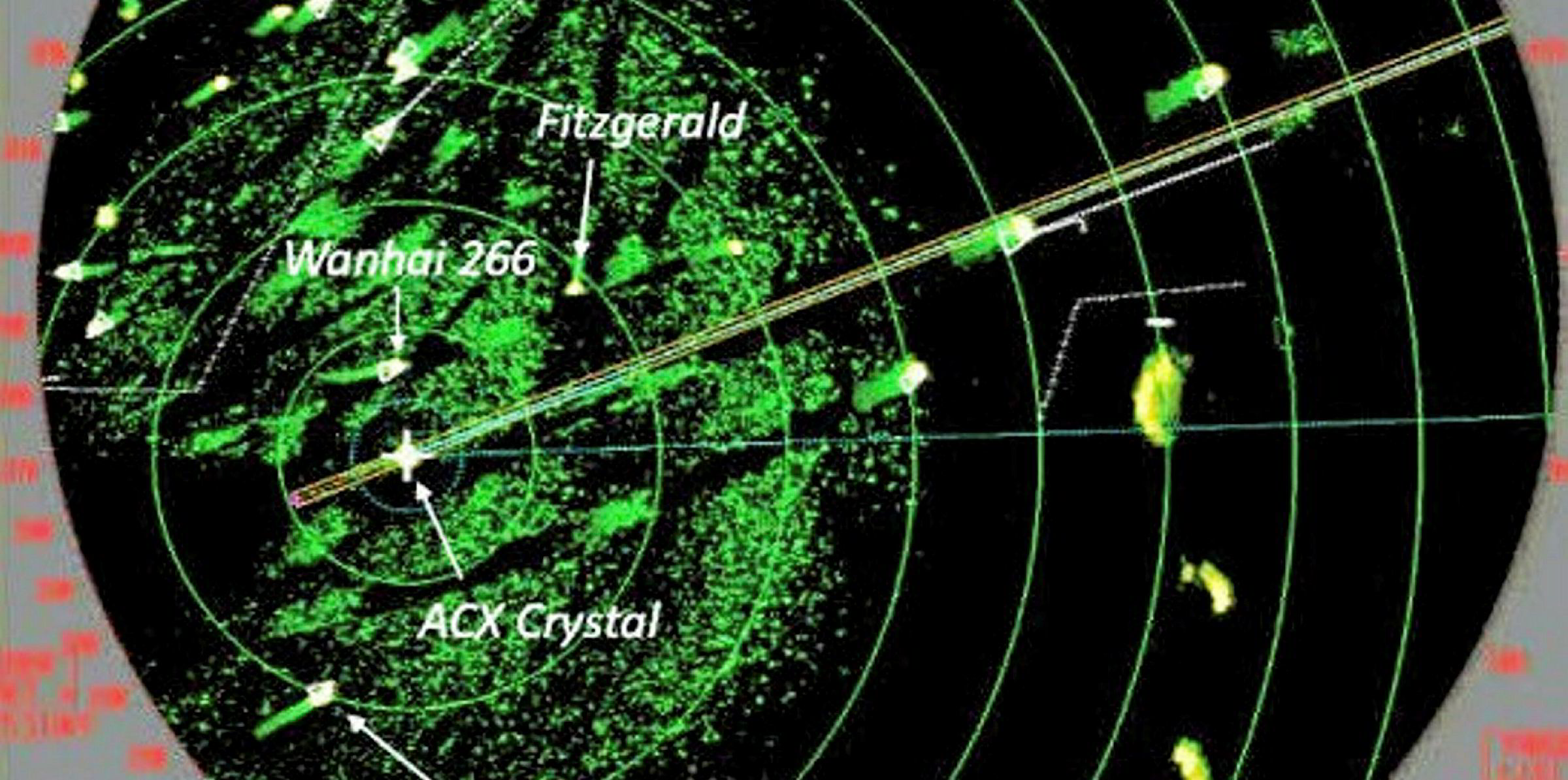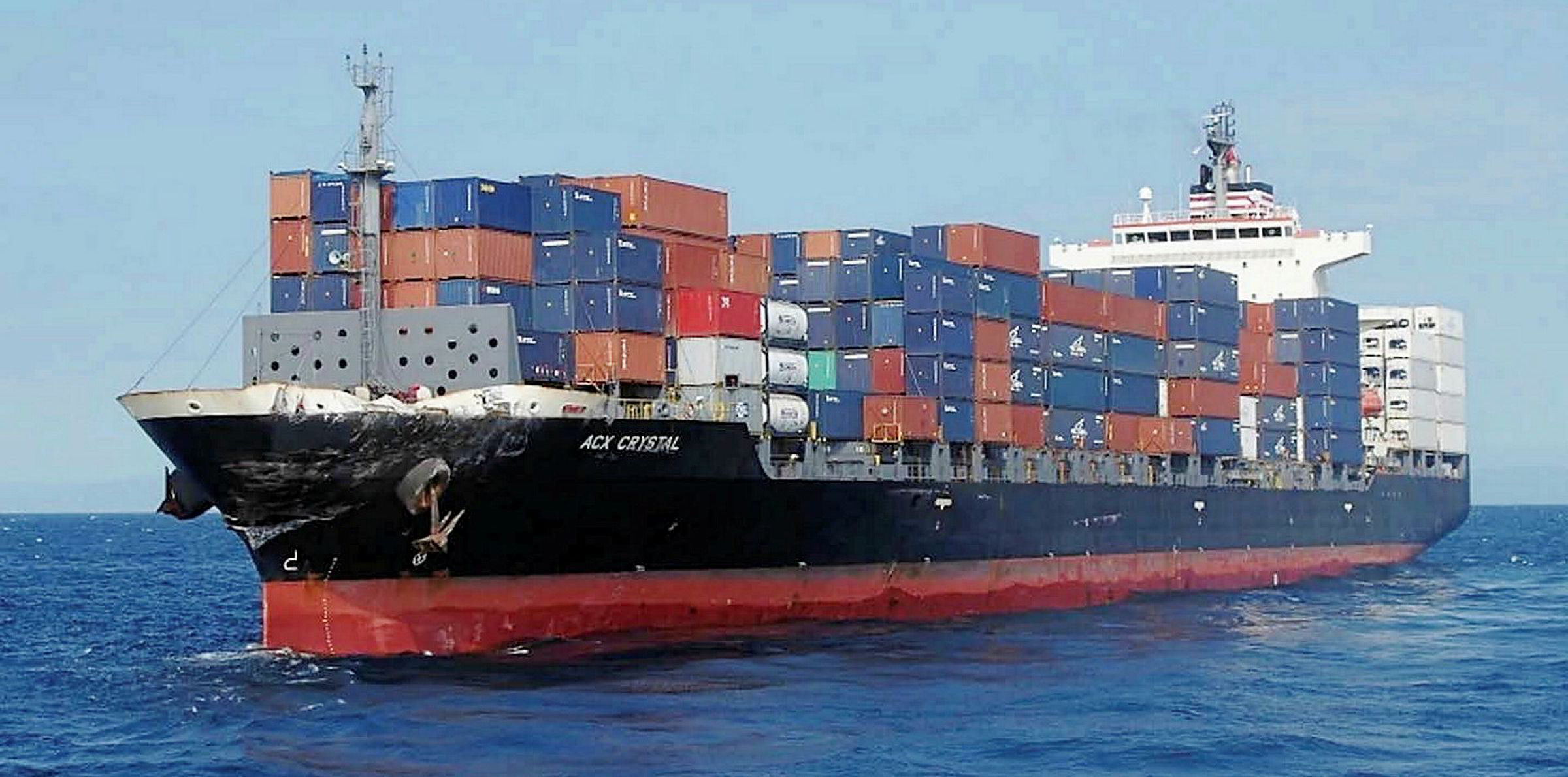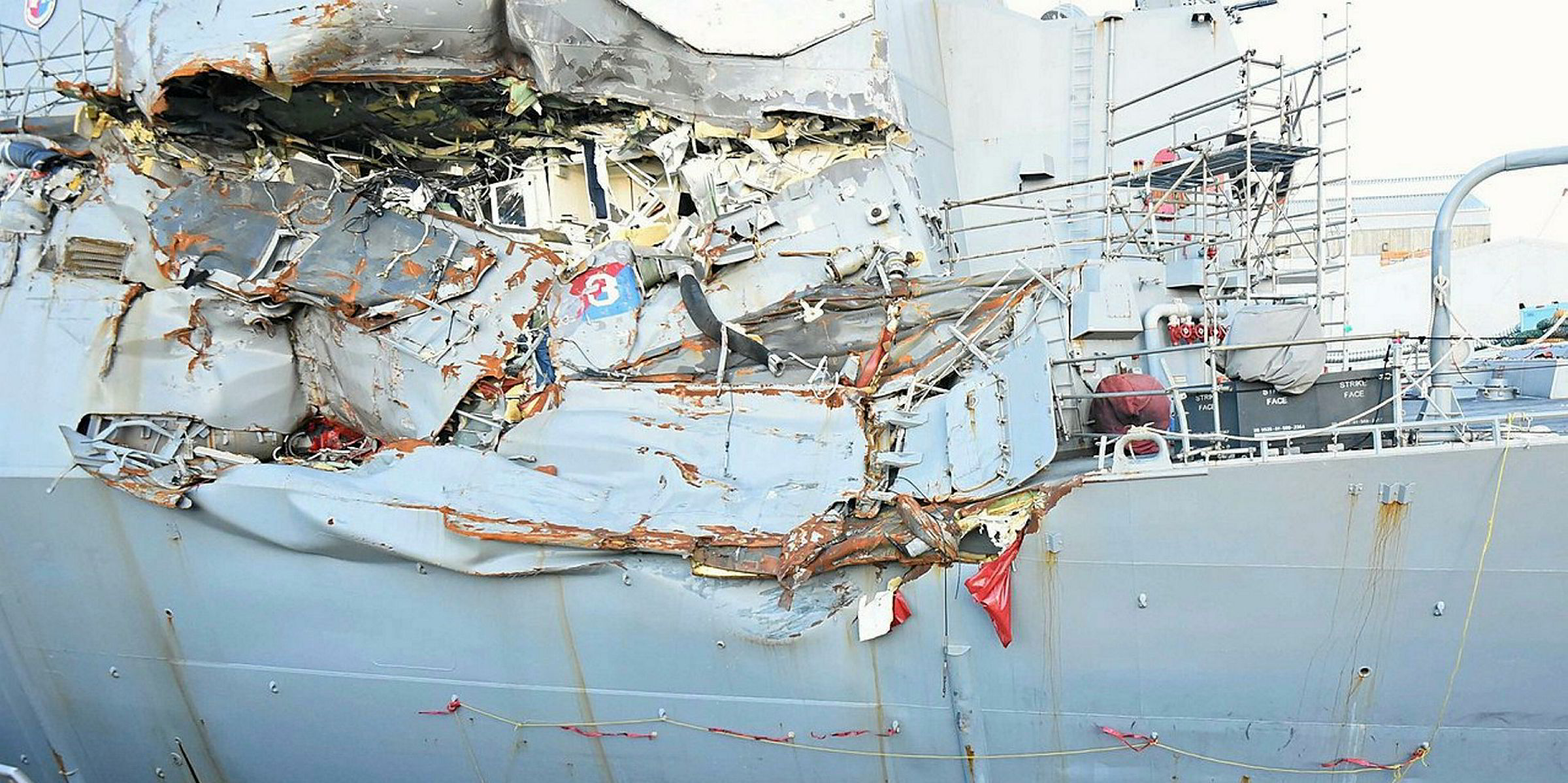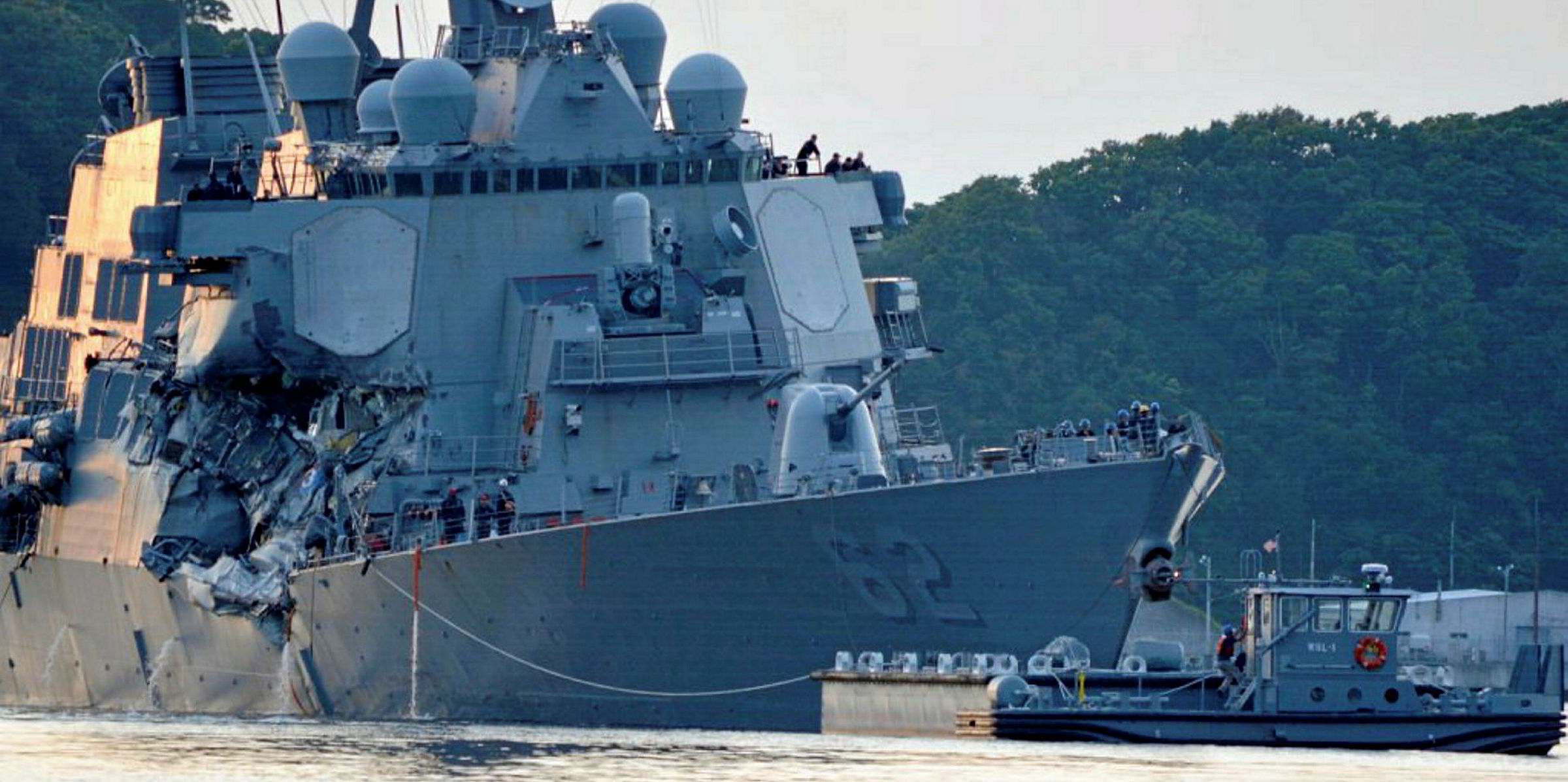As an NYK Line-chartered containership transited a busy corridor off Japan in the early morning darkness, its radar displayed a faint signature of an approaching ship.
Then, the signal disappeared.
The signature returned and faded several times over the next few minutes, but once it steadied, it would turn out to be a much larger ship than appeared on the radar display, according to an accident investigation report.
What the seafarers on the bridge of the 2,858-teu ACX Crystal (built 2008) would never see was an AIS signal from the warship that would eventually collide with their vessel in a deadly 2017 incident.
A US investigation into the casualty involving the Philippines-flagged containership and the destroyer USS Fitzgerald has raised questions over the US Navy's practice of not broadcasting AIS signals from its ships.
The final National Transportation Safety Board (NTSB) report into the incident found that the USS Fitzgerald had its AIS system in receive-only mode, as a matter of navy policy, ahead of the 17 July 2017 collision. The incident killed seven US sailors, injured three and caused $300m in damages to the destroyer. The ACX Crystal was also damaged, though there were no injuries among its crew.
Navy blamed
While the NTSB focused most of the blame for the casualty on the USS Fitzgerald bridge team’s failure to take action to avoid a collision in time, it has asked the US Navy begin using AIS when in the vicinity of commercial vessel traffic.
AIS is a communication system that transmits a vessel's identification and location information to ships around it. While in recent years it has become a key tool for tracking ships for commercial, legal and military purposes, it is at its core a safety system intended to help prevent collisions.
AIS' are a navigation safety tool that automatically transmit key vessel information every two to 12 seconds.
The information includes a vessel's name, type, position, course, speed, navigational status and other safety-related information.
The information is received by other ships in the vicinity, as well as shore stations, aircraft and satellites that enable global ship tracking.
The USS Fitzgerald's failure to transmit its information on AIS meant that ships in a busy shipping area off Japan's Honshu Island had to rely on visual means or radar to stay on a safe course near the vessel.
But there is a catch: the destroyer was designed to appear smaller on a radar screen than it is in reality.
"The destroyer’s radar signature appeared significantly smaller than that of a comparable merchant vessel of the same size on the radar on the ACX Crystal, the containership with which it later collided," the NTSB said in a long-awaited, 50-page report.
However, the report also pointed to failure by the ACX Crystal's second officer to take steps using other technology to help avoid the collision.
On the day of the incident, the disappearing, reappearing signal of the USS Fitzgerald first showed up on the containership's radar at 1:06 am local time, when the destroyer was 13 nautical miles (24.1 km) away.
By 1:15 am, the USS Fitzgerald's signal became steady on the ACX Crystal's radar, and four minutes later the containership changed course while the destroyer was 6.5 nautical miles away.

The second officer on the containership later acknowledged he was aware of the USS Fitzgerald's signal on radar, and the NTSB said it concluded that the navy vessel had a detectable radar signature.
The agency said the second officer should have homed in on the USS Fitzgerald signal on the containership's automatic radar plotting aid (ARPA) system, which provides course, speed, range, bearing and other key details of acquired targets.
"The second officer on board the ACX Crystal should have acquired the destroyer on the ARPA to determine risk of collision," said the agency, which also concluded that the officer did not take aggressive enough actions to communicate with the USS Fitzgerald or avoid a collision.
But AIS data would have provided more information, including a vessel's name, type, position, course, speed and navigational status. The NTSB found that, while the ACX Crystal second officer was using radar to plot even smaller targets, an AIS signal would have helped him realise that the radar contact represented a US Navy destroyer.
"Assessing risk of collision can be and has been successfully accomplished without AIS. However, the worldwide, mandatory use and acceptance of AIS as an added tool to navigators’ 'all available means' can assist in assessing risk of collision," the safety agency said.
Since the collision, the US Navy has ordered its ships to transmit AIS data when transiting traffic separation schemes and other high traffic areas. But the NTSB, whose recommendations call for its use whenever commercial traffic is present, said the the commanding officer of the USS Fitzgerald already had a similar order in place for his vessel.
"Since the 2017 collisions, AIS use is governed by the policies promulgated by each respective Numbered Fleet Commander, which authorise commanding officers to broadcast AIS in high traffic areas," said US Navy spokesman Lieutenant Rob Reinheimer.
He said the Navy has learned a great deal from the Fitzgerald tragedy.
"We have applied those lessons aggressively to the way we train, operate and fight our ships throughout the surface fleet. Our Sailors sail confidently and safely every day," he said.
Sea Quest could not be reached for this story.
"NYK Line has cooperated fully with the investigation into the June 2017 incident, but as a company we never comment on legal matters that are impending or before the courts," the ship's Japanese charterer said.

The NTSB made four safety recommendations in its final report on the collision between the destroyer USS Fitzgerald and the containership ACX Crystal. Three of the recommendations were aimed at the US Navy, while one focused on Sea Quest Ship Management, the Philippines-based manager of the ACX Crystal.
- The navy should review and revise fleetwide training and qualification requirements for deck officers, particularly as they relate to collision avoidance regulation.
- The navy should also review bridge resource management training to improve the team environment and communication on the bridge of its vessels.
- The navy should broadcast IAIS data whenever in the vicinity of commercial vessel traffic, except when there are strategic or tactical reasons to not do so.
- Sea Quest Ship Management should provide additional training to navigation officers on collision avoidance, regulations, radar and automatic radar plotting aid systems.






